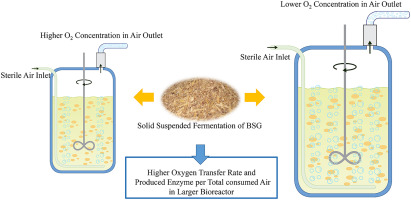Biomass & Bioenergy ( IF 6 ) Pub Date : 2019-10-01 , DOI: 10.1016/j.biombioe.2019.105386 H. Moteshafi , S.M. Mousavi , M. Hashemi

|
The high loading of lignocellulosic substrates could merge the advantages of solid-state and submerged fermentations. However, high solid loading in bioreactors could result in oxygen mass transfer complications and caused extra waste of inlet air. In this work, the effects of Brewer's Spent Grain (BSG) loading on enzyme production, oxygen transfer rate (OTR) and carbon dioxide evolution rate (CER) were investigated at 50, 75 and 100 g L−1 BSG in a 2.5-L stirred tank bioreactor. However, in small-scale bioreactor, the short contact time and inadequate mixing of bubbles in liquids affected the OTR and gas holdup negatively. Therefore, xylanase production in a 14-L vessel with 100 g L−1 BSG has been studied. In a larger bioreactor, a remarkable improvement in OTR and a significant reduction in total air consumption were recorded. Furthermore, the enzyme production per 1 L of consumed air was four times greater than 2.5-L vessels. As a result, the energy consumption for aeration was less in the larger bioreactor with high solid loading. Additionally, the residual xylan content monitoring during enzyme production has revealed that the BSG's xylan content decreased in the first 12 h of cultivation and then it remained approximately constant that probably means further xylanase induction is influenced by the concentration of BSG's hydrolysis products. Concisely, it seems that initial higher solid loading could be used as a practical alternative to solid substrate feeding during the fermentation. These findings would be useful for the fermentation of high loading lignocellulosic material in the industrial-scale bioreactor.
中文翻译:

高BSG悬浮发酵中的曝气挑战:搅拌罐生物反应器规模的影响
木质纤维素底物的高负载可以融合固态发酵和淹没式发酵的优势。但是,生物反应器中较高的固体负载量可能导致氧气传质复杂化,并导致进口空气的额外浪费。在这项工作中,在2.5升,50升,75升和100升L -1 BSG条件下,研究了Brewer的废谷物(BSG)装载量对酶产生,氧气传输速率(OTR)和二氧化碳释放速率(CER)的影响。搅拌槽生物反应器。然而,在小型生物反应器中,较短的接触时间和液体中气泡的不充分混合会对OTR和气体滞留率产生负面影响。因此,在具有100 g L -1的14 L容器中生产木聚糖酶已经研究了BSG。在更大的生物反应器中,记录到了OTR的显着提高和总空气消耗的显着减少。此外,每1升消耗的空气产生的酶量是2.5升容器的四倍。结果,在较大的具有高固含量的生物反应器中,通气的能量消耗较少。此外,在酶生产过程中对残余木聚糖含量的监测表明,在培养的前12小时中BSG的木聚糖含量下降,然后保持大致恒定,这可能意味着进一步的木聚糖酶诱导受到BSG水解产物浓度的影响。简而言之,似乎在发酵过程中初始较高的固体负载量可以用作固体底物进料的实用替代方法。



























 京公网安备 11010802027423号
京公网安备 11010802027423号